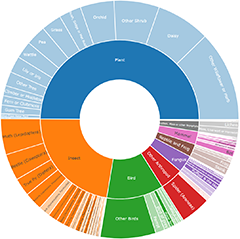Orchids
There are about 30,000 species of orchid worldwide making Orchidaceae the largest family of flowering plants. They are found in a diverse range of habitats.
Orchids have distinctive flowers, consisting of three sepals and three petals. The third petal is greatly modified into a specialised structure known as a labellum. Another distinctive feature is the column, a fusion of the sexual parts of the flower (stamens and style) into a fleshy structure. Most terrestrial orchids grow from a tuber which is replaced each year.
Some orchids are designated as rare and endangered plants. Others, although reasonably common, are very localised in their occurence. All orchids are protected species and should not be disturbed in their native habitat. For these reasons all orchids have been included as rare or sensitive plants.
Announcements
There are currently no announcements.
Discussion
We have seen D. amabilis there in the past. (Others from Friends of Grasslands have, I mean.)
Diuris chryseopsis
Diuris chryseopsis
Hymenochilus bicolor (ACT) = Pterostylis bicolor (NSW)
Hymenochilus bicolor (ACT) = Pterostylis bicolor (NSW)
Top contributors
- AaronClausen 1.3K
- CathB 1.2K
- AlanS 1K
- TobiasHayashi 986
- Tapirlord 939
- AnneG1 546
- RobG1 512
- Csteele4 512
- MattM 502
- NedJohnston 483
Top moderators
- MattM 4.9K
- TonyWood 3.1K
- Tapirlord 3K
- CathB 2.8K
- TobiasHayashi 2.3K
- DerekC 1.1K
- RobG1 1K
- AlanS 1K
- MichaelMulvaney 702
- plants 403










































































































